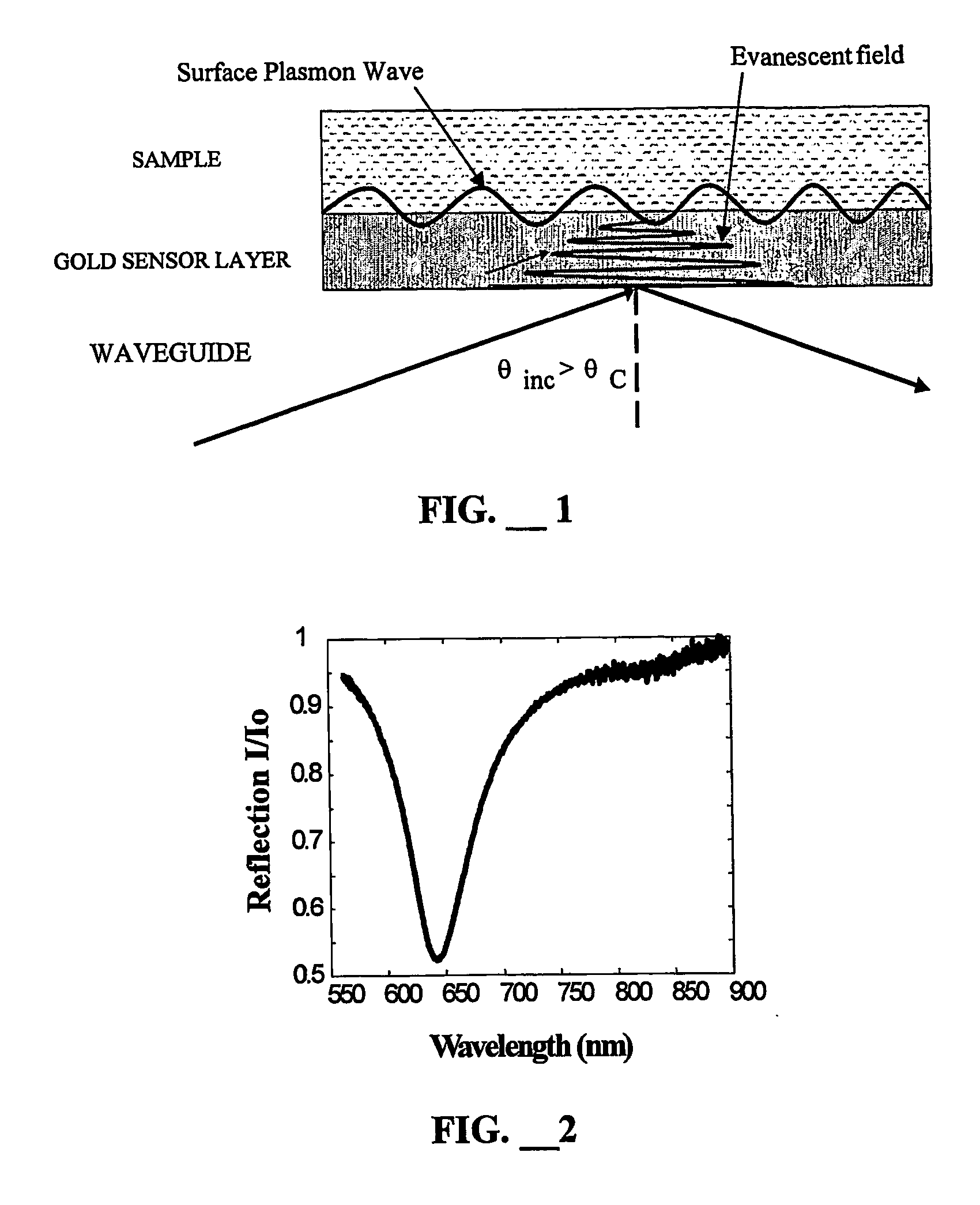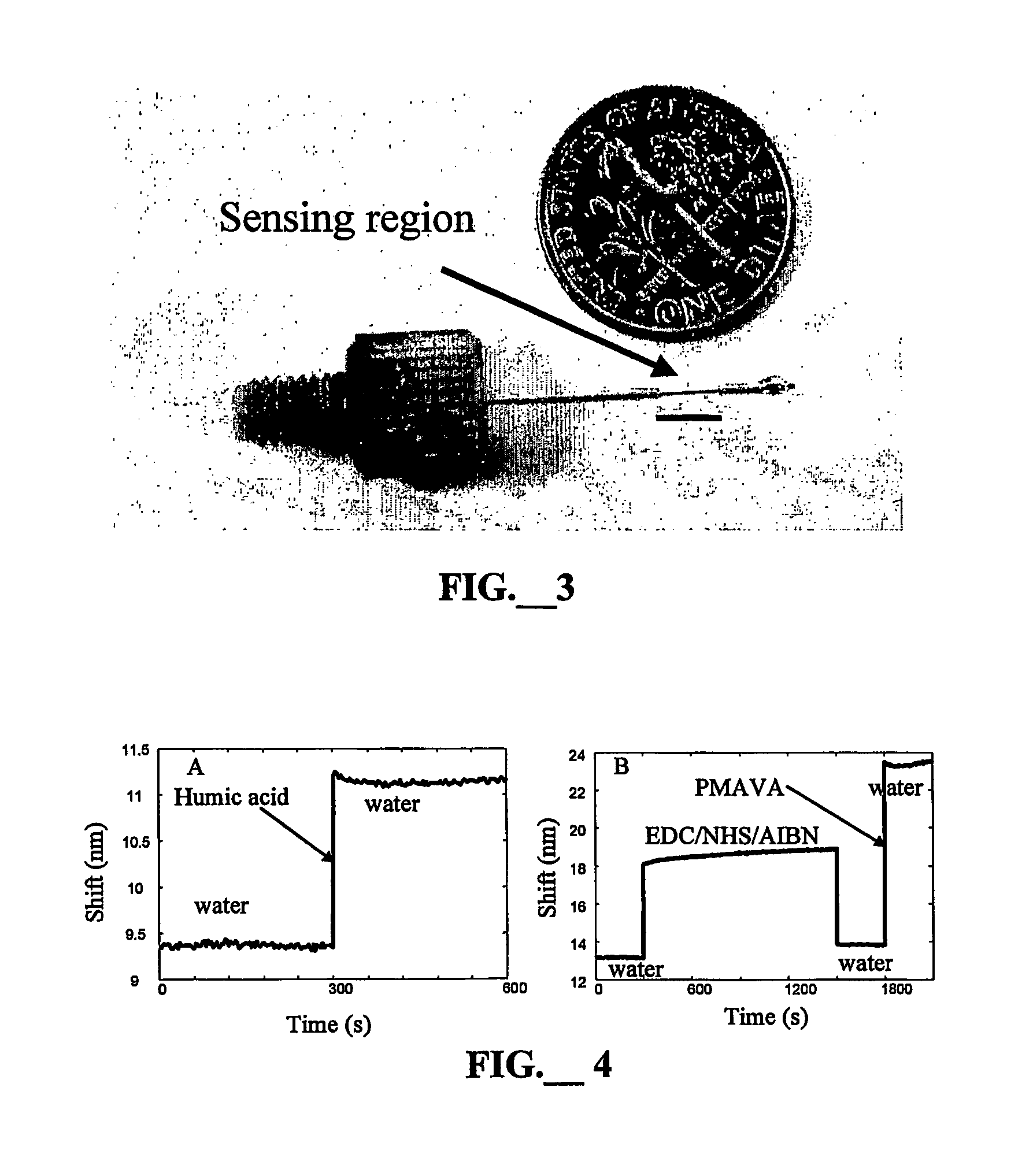Biocompatible linkers for surface plasmon resonance biosensors
a biosensor and surface plasmon technology, applied in the field of medical diagnostics, can solve the problems of protein fouling still present, cm-dextran has failed as a support, etc., and achieve the effect of reducing protein fouling
- Summary
- Abstract
- Description
- Claims
- Application Information
AI Technical Summary
Benefits of technology
Problems solved by technology
Method used
Image
Examples
example 1
[0037] The manufacture of the SPR sensors used in this study has been described previously (L. A. Obando and K. S. Booksh, Anal. Chem., 1999, 71:5116). Here 400-micron diameter multimode fiber optics were employed for the sensor tip. However, multimode fibers as narrow as 50 microns can also be used. In the current configuration, fibers 45 mm long were cleaved. An 11-mm long piece of the buffer protecting the fiber was removed, and 5 mm is replaced to protect the mirror on the distal end (FIG. 3). The distal end was polished with 5 micron and 1 micron lapping films. The distal end was then washed with isopropanol and the sensor was dried at 100° C. for 10 minutes. A 5 nm adhesion layer of chromium (Cr) was sputtered on the distal end of the sensor, and a 50 nm layer of gold (Au) was deposited to form a mirror. The mirror was sealed by oven cured epoxy. Ten to 15 mm of the buffer on the other end of the fiber was removed. The fiber was installed on the connector and fixed in place us...
example 2
Ge Attenuated Total Reflection Fourier Transform Infra-Red Spectroscopy System
[0038] The polymer attachment on the gold surface was monitored using GATR-FTIR. The analysis of the polymer coated glass slides was performed using a Bruker IFS66v / s FTIR with an MCT detector cooled by liquid nitrogen (Billerica, Mass.). A Harrick GATR attachment (Ossining, N.Y.) was also used. The germanium crystal was washed with methyl ethyl ketone and the coated glass slides were placed face down on the crystal. The GATR attachment was placed in the FTIR and the compartment was evacuated to 1 mbar. Transmission spectra were comprised of the average of 1024 scans with the background subtracted. Precleaned glass slides were washed with acetone. A 5 nm layer of Cr and 50 nm layer of Au were deposited on the glass slide. The slides were modified chemically as described below. Upon completion of the reactions, the polymer coated gold slides were washed with ethanol and dried with compressed air. The slid...
example 3
3.a. CM-dextran, CM-hyaluronic Acid and Hyaluronic Acid Layer Preparation
[0040] The synthesis of these layers was based on the CM-dextran chemistry used elsewhere for protein immobilization on an SPR surface (S. Lofas and B. Johnsson, J. Chem. Soc. Chem. Comm., 1990,21:1526; B. Johnsson, S. Lofas and G. Lindquist, Anal. Biochem., 1991, 198:268). All reactions occurred in aqueous solution without any stirring or shaking. The bare gold surface on the SPR probe was contacted overnight with 0.005 M 11-mercaptoundecanol in an 80:20 solution of ethanol and water to form a self-assembled monolayer (SAM). This SAM was reacted with 0.6 M epichlorohydrin in a 1:1 mixture of diglyme and 0.4 M NaOH for four hours. This layer was washed with water, ethanol and water again. The surface was reacted for 20 hours with an aqueous solution containing 0.3 g / mL dextran or 0.3 g / mL hyaluronic acid (Fisher, Hampton, N.H.) and 0.1 M NaOH. Stopping at this stage produced a h...
PUM
| Property | Measurement | Unit |
|---|---|---|
| thick | aaaaa | aaaaa |
| pH | aaaaa | aaaaa |
| pH | aaaaa | aaaaa |
Abstract
Description
Claims
Application Information
 Login to View More
Login to View More - R&D
- Intellectual Property
- Life Sciences
- Materials
- Tech Scout
- Unparalleled Data Quality
- Higher Quality Content
- 60% Fewer Hallucinations
Browse by: Latest US Patents, China's latest patents, Technical Efficacy Thesaurus, Application Domain, Technology Topic, Popular Technical Reports.
© 2025 PatSnap. All rights reserved.Legal|Privacy policy|Modern Slavery Act Transparency Statement|Sitemap|About US| Contact US: help@patsnap.com



